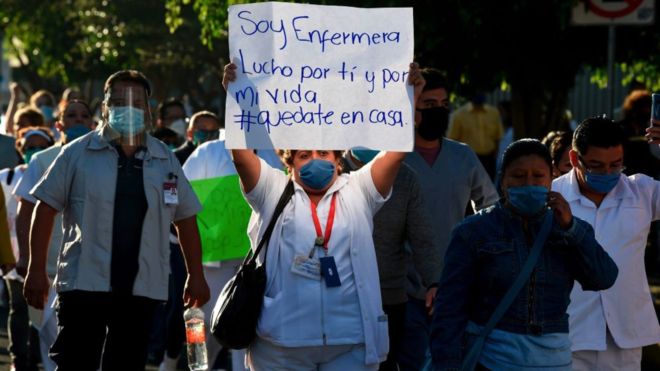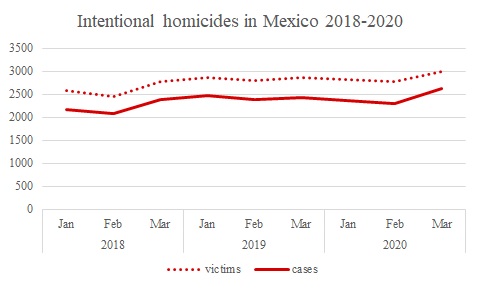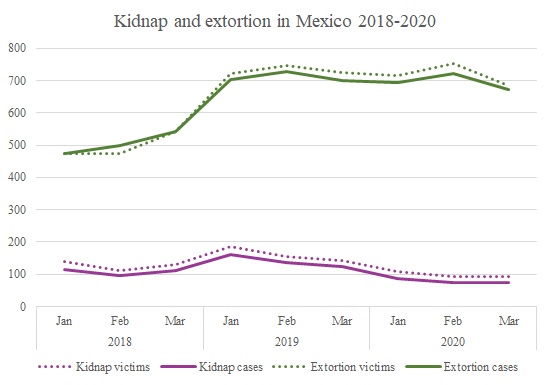05/06/20 (written by lcalderón) – As the world faces the unprecedented COVID-19 pandemic, members of the government and the academic community in Mexico expected to see a decrease in violent crime after the federal government implemented the “Stay Home” initiative. According to The New York Times, this seems to have been the case for other Latin American countries, where quarantine and travel restrictions have reduced the incidence of crime in places like Brazil, Colombia, El Salvador, Honduras, etc.
However, Mexican media sources such as El Universal claim that violence in Mexico has not decreased and continues to rise. The Associated Pressreported that places like Guanajuato, Michoacán, and Chihuahua –particularly the municipality of Juárez– have experienced higher levels of violence despite the pandemic. Some of this violence has targeted members of the medical profession because of the supposed risk of contagion they bring to their communities. Nurses have been burned with bleach, clinics have been set on fire, and some medical professionals have been verbally assaulted, making healthcare workers afraid of wearing their uniforms outside the hospitals.

COVID-19 measures in Mexico
Mexico adopted “Sana Distancia” or social distancing on March 16, 2020 in an attempt to flatten the curve of COVID-19 contagions. By March 30, a sanitary emergency was declared, calling on citizens to stay in quarantine, avoid social gatherings, and only leave home when necessary. In addition, officials ordered all activities for non-essential businesses to cease and reduced operations in essential enterprises, hoping to reduce the exposure of essential workers to the virus.
In theory, there are two reasons why having less people in the streets could result in a significant reduction in crime. First, there are fewer victims because there are fewer people in public that could potentially become victims of violence. Second, there are fewer perpetrators of violence because potential assailants are also following stay-at-home orders. Yet on the ground, the statistics tell another story. President Andrés Manuel López Obrador admitted that the quarantine measures had not yielded decreased levels of violence, as was initially projected, but he remains hopeful that such reductions will be observed over time. In an unprecedented move, the president even addressed his daily morning speech on April 20, 2020 to drug traffickers and criminals asking them to reduce the levels of violence amidst the crisis.
Analyzing crime trends
Although it is still too soon to analyze the real consequences of these public health measures in 2020, violent crime in Mexico has followed a distinctive pattern over the years. Violent crime is regularly registered by General Attorney offices and reported by Mexico’s Secretary General of National Public Security (Secretariado Ejecutivo del Sistema Nacional de Seguridad Pública, SESNSP). If one compares these national figures from January through March 2020 with the same period in 2019, it is noteworthy that both years had the same number of intentional homicides during that quarter (7,279 cases). Although the total for each month differed, March was the most lethal month in both years. The two main differences between this period in 2019 and that in 2020 are a 2.1% increase in the use of firearms to commit homicide and a 5.3% increase in the number of femicides.
In terms of other violent crime, 2020 showed decreased numbers for cases of kidnapping and robbery (including burglary, commercial robbery and theft), with a 44.4% reduction in reported kidnappings and a 10.7% decrease in robbery. Cases of theft decreased 15.5% from 2019 to 2020, the greatest drop among any type of robbery. The only steady increase shown in the first three months of 2020 was in cases of assault. For the same period in 2019, there were 38,067 cases of assault, while in 2020 that number was 38,267, or a 0.53% increase.
The Secretary General of National Public Security (SESNSP) also reports the total number of victims for a given crime. When analyzing the number of victims for each crime, March 2020 was the deadliest month (3,000 victims) since July 2018, when SESNSP reported 3,074 victims of intentional homicide. However, taking into account the previous comparison looking at January through March 2020 against the same months in 2019, there is less than a 1% increase in the number of victims of homicide in the new year.

The other two crimes that experienced an increase in the number of victims in the first three months of 2020 compared to 2019 were assault with a 1.12% increase and femicide with a 1.24% increase in total victims. At the same time, victims of kidnapping and extortion decreased by 39% and 1.78%, respectively.

As Mexico continues to extend the “Stay Home” period, it is important to continue to analyze crime data to determine whether COVID-19 has had a significant impact on levels of violence in Mexico. Specifically, this will help to ascertain whether or not initiatives like social distancing and self-isolation lead to reductions in crime. As such, crime data for April and May will be key to determine if it is accurate to say that COVID-19 measures have had the same impact in Mexico (nationwide) as in other Latin American countries.
Sources:
Miranda, Justino et al. “COVID-19: Healthcare workers experience discrimination and violence in Mexico.” El Universal. April 27, 2020. https://www.eluniversal.com.mx/english/covid-19-healthcare-workers-experience-discrimination-and-violence-mexico
“Mexico’s gang violence appears to rise during pandemic.” The Associated Press. April 24, 2020. https://apnews.com/a33c15a157abcf26d52de04bd16ab474
“En México hay más gente llorando por la violencia que por el coronavirus: experto.” El Universal. April 23, 2020. https://www.eluniversal.com.mx/nacion/en-mexico-hay-mas-gente-llorando-por-la-violencia-que-por-el-coronavirus-experto
“Incidencia delictiva del Fuero Común, nueva metodología.” Secretariado Ejecutivo del Sistema Nacional de Seguridad Pública. April 20, 2020. https://www.gob.mx/sesnsp/acciones-y-programas/incidencia-delictiva-del-fuero-comun-nueva-metodologia?state=published
Grupo REFORMA. “La mañanera de AMLO – 20 de abril.” Reforma. April 20, 2020. https://www.reforma.com/libre/acceso/accesofb.htm?urlredirect=/la-mananera-de-amlo-20-de-abril/ar1923705
“Víctimas y unidades robadas, nueva metodología.” Secretariado Ejecutivo del Sistema Nacional de Seguridad Pública. April 20, 2020. https://www.gob.mx/sesnsp/acciones-y-programas/victimas-nueva-metodologia?state=published
Simple, Kirk and Azam Ahmed. “El virus disminuye la criminalidad en América Latina (por ahora).” The New York Times. April 13, 2020. https://www.nytimes.com/es/2020/04/13/espanol/america-latina/coronavirus-delincuencia-crimen.html




